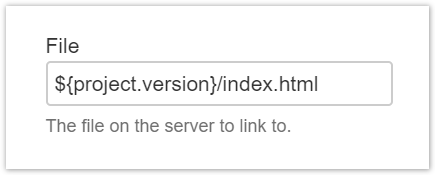- Created by Robert Reiner, last modified on 02. Jun 2021
projectdoc Toolbox
Links to a resource on a server.
- Categories
- Tags
- Extension
- Since
- 1.0
The System Link Macro allows to render a link to a resource on a remote server. The system is identified via Confluence shortcuts or space properties.
Since projectdoc Toolbox version 1.11 this macro is part of the Information Systems Extension. Prior to that version the macro has been part of the projectdoc Toolbox.
The Since attribute above refers to the version of the extension, not to the version of the projectdoc Toolbox.
Properties
Label
The label for the link. Defaults to the name of the file - and if not given - the identifier of the system.
The value may contains property placeholders.

Tooltip
The tooltip to render with the like. May contain placeholders.
System Identifier
Identifies the connection information via Confluence shortcuts or space properties.
The system identifier is checked at three locations
Typically do not change the system identifier provided by the macro (if one is specified). Keep the default value of '
The search for the system connection information is conducted as follows. Use the URI discovered first to connect to the server.
- Check for a space property
url- - Check for a space property
Only available with projectdoc Toolbox version 1.11 and up! - Check for a space property
shortcut-id-.
Lookup the connection information from the shortcut links with the value retrieved from the space property. - Check the shortcut links for a value
- Check application navigator for a value
If no value is specified at any of the locations above, the macro renders an error message like this:

In this example for a system macro the referenced, but undefined system, is called test-repo.
The system identifier is added as CSS class to the link element.
System Type
Identifies the type of system referenced.
If no system identifier is specified, the system type is used as default. If no predefined system type is applicable, use generic.
The system type is added as CSS class to the link element.
Since version 1.0.
File
The file on the server to link to.
The value may contains property placeholders.

Control with the Check Resource parameter, how the macro should signal a missing resource.
Delimiter
The delimiter to check in case the file is appended. If the delimiter is neither the last character of the system URL nor the first character of the file then this delimiter is inserted between the system URL and file name.
The delimiter is required to be one character. If more characters are specified, for instance none, then no delimiter will be inserted.
If no value is specified, the default delimiter is '/'.
Since 3.4
Available since version 3.4 of the Information Systems Extension.
Apply Space Properties
If checked the properties defined by the space of the document this macro is part of are applied as defaults.
Render Full URL
If checked and no label specified the URL is rendered in full.
Check Resource
If checked, the resource the URL points to is checked for existence.
Dependent on whether the resource exists or not a CSS class is added.
| CSS Class | Status |
|---|---|
projectdoc-resource-exists | Resource exists |
projectdoc-resource-not-exists | Resource does not exist |
Note that the check does not use any application link configuration (available since version 1.4). The autoconvert service does. Hence a link macro may show the title of the referenced page as a label, but still is a dead link for users with insufficient privileges.
Details
Autoconvert
To create the macro authors may simply paste the URI to the resource to the editor.
All is needed is a configuration of the resource repository base URI. For more information on this topic, please refer to Autoconvert Information System URIs.
Labels for the generated link may be determined correctly (i.e. will show the title of the page) even if the page needs authentication to be accessed. See Authentication for details.
In case you need to use the macro on URLs pointing to the Confluence instance, you should use the tiny URLs. Otherwise (usually) the Confluence built-in autoconverter will take priority in converting the link.
You can determine the tiny URL easily by typing 'k' in the view mode of a page.
Related macros
The following macros help with referencing resources on other information servers:
- Enterprise Architect Image Link Macro
- Renders an image generated from an Enterprise Architect diagram, transcluded from a server.
- HTML Snippet Macro
- Transclude HTML content from a remote server.
- Javadoc Link Macro
- Links API documentation pages for Java elements.
- Nexus Link Macro
- Renders a link to an artifact stored on a Nexus server.
- System Image Link Macro
- Renders an image transcluded from a remote server.
- System Transclusion Macro
- Transclude content from a resource from a remote system.
- Text Snippet Macro
- Transclude text content from a remote server.
Resources
- Confluence as the Information Hub
- Tools from the projectdoc Toolbox to import from and export to other information systems.




